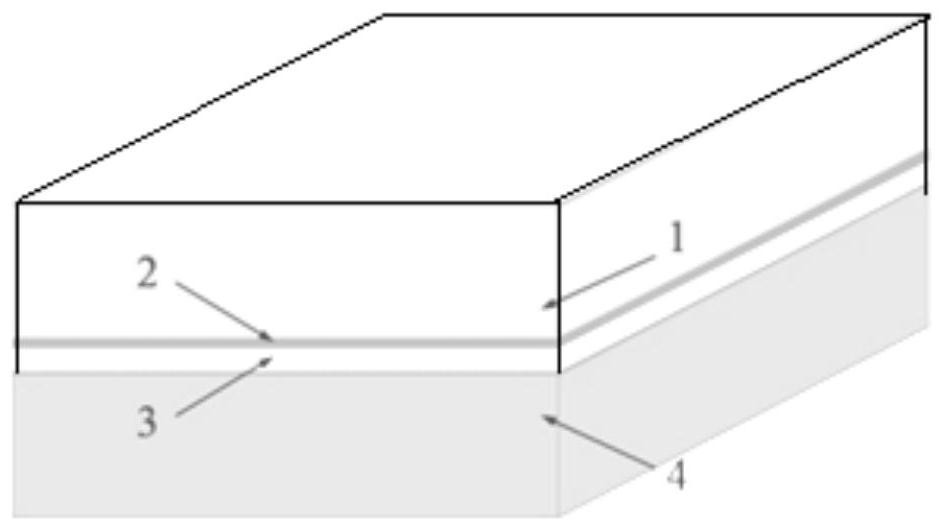A method for diffusion bonding dissimilar materials using an amorphous interlayer
A technology of diffusion joining, dissimilar materials, applied in welding equipment, non-electric welding equipment, welding/welding/cutting items, etc., which can solve the problem of inter-layer intermetallic compounds and corrosion, reduced dimensional accuracy of weldments, high welding pressure and temperature, etc. problems, to achieve the effect of lowering melting point, reducing welding defects, and improving corrosion resistance
- Summary
- Abstract
- Description
- Claims
- Application Information
AI Technical Summary
Problems solved by technology
Method used
Image
Examples
Embodiment 1
[0024] TC4 titanium alloy and Si 3 N 4 For ceramic dissimilar material welding, a nanocrystalline thin layer with the same composition as the metal base material is prepared by magnetron sputtering on the surface of the titanium alloy base material to be welded, with a thickness of 2 μm. The alloy with the same composition as the titanium alloy base material was prepared by strip-throwing method to form an amorphous strip as an intermediate layer with a thickness of 30 μm. The amorphous strip was placed between the titanium alloy and the ceramic surface to be welded and fixed with tooling. Put two workpieces to be welded with a nanocrystalline thin layer and an amorphous intermediate layer into a vacuum furnace, apply a pressure of 2 MPa on the surface to be welded, and wait until the vacuum degree in the furnace drops to 5.0×10 -3 Below Pa, heat up the furnace at a heating rate of 10°C / min, and wait for the temperature to rise to 950°C for 30 minutes for diffusion connection...
Embodiment 2
[0026] Copper alloy and TC4 titanium alloy dissimilar materials are welded, and a layer of nanocrystalline thin layer with the same composition as the metal base material is prepared on the surface of the titanium alloy base material to be welded by magnetron sputtering, with a thickness of 3 μm. The alloy with the same composition as the copper alloy base material was prepared by strip-spinning method to form an amorphous thin strip as the intermediate layer with a thickness of 40 μm. The amorphous thin strip was placed between the copper alloy and the titanium alloy to be welded and fixed with tooling. Put two workpieces to be welded with a nanocrystalline thin layer and an amorphous intermediate layer into a vacuum furnace, apply a pressure of 4 MPa on the surface to be welded, and wait until the vacuum degree in the furnace drops to 5.0×10 -3 Below Pa, heat up the furnace at a heating rate of 12°C / min, and wait for the temperature to rise to 900°C for 40 minutes for diffusi...
Embodiment 3
[0028] Copper alloy and ZrO 2 For ceramic dissimilar material welding, a nanocrystalline thin layer with the same composition as the metal base material is prepared by magnetron sputtering on the surface of the copper alloy base material to be welded, with a thickness of 4 μm. The alloy with the same composition as the copper alloy base material was prepared by strip-throwing method to form an amorphous thin strip as an intermediate layer with a thickness of 50 μm. The amorphous thin strip was placed between the copper alloy and the ceramic surface to be welded and fixed with tooling. Put two workpieces to be welded with a nanocrystalline thin layer and an amorphous intermediate layer into a vacuum furnace, apply a pressure of 6 MPa on the surface to be welded, and wait until the vacuum degree in the furnace drops to 5.0×10 -3 Below Pa, heat up the furnace at a heating rate of 13°C / min, and wait for the temperature to rise to 850°C for 45 minutes for diffusion connection. Aft...
PUM
| Property | Measurement | Unit |
|---|---|---|
| thickness | aaaaa | aaaaa |
| thickness | aaaaa | aaaaa |
| thickness | aaaaa | aaaaa |
Abstract
Description
Claims
Application Information
 Login to View More
Login to View More - R&D
- Intellectual Property
- Life Sciences
- Materials
- Tech Scout
- Unparalleled Data Quality
- Higher Quality Content
- 60% Fewer Hallucinations
Browse by: Latest US Patents, China's latest patents, Technical Efficacy Thesaurus, Application Domain, Technology Topic, Popular Technical Reports.
© 2025 PatSnap. All rights reserved.Legal|Privacy policy|Modern Slavery Act Transparency Statement|Sitemap|About US| Contact US: help@patsnap.com

